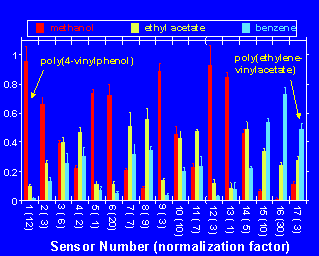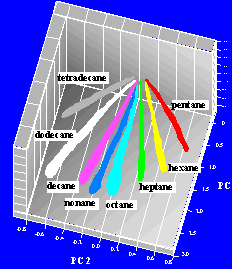Science Fiction
Dictionary
A B C D E F G H I J K L M N O P Q R S T U V W X Y Z
Caltech Electronic Nose: The Lewis Group Smells Success

The Lewis Group, at Caltech, has worked out a unique approach to the idea of an electronic nose. They use arrays of simple, readily fabricated, chemically sensitive conducting polymer films.

(Response patterns for three different solvents
on a 17 element sensor array.)
When a polymer film is exposed to a vapor, some of the vapor partitions into the film, causing it to swell. The electronic nose detects this as an increase in the electrical resistance of the film, a value that can be quantified for each film.

(20 detector array creates pattern identifying
the vapor and concentration)
An array of sensors that respond individually to vapors can produce a unique pattern for a given vapor mixture. Pattern recognition done on the output signals from the electronic nose can classify, identify and even quantify, the odor being investigated. The researchers claim that this response is very similar to the way that our own olfactory sense produces diagnostic patters and then sends them to the brain.
The Caltech nose has been demonstrated to detect odors in an ordinary room background; it can direct robotics to turn toward the source of the odor. Signals can be read in real-time or near real-time, because the swelling of the polymer begins immediately after exposure to the vapor.
Even better, the Caltech nose can be used over and over (just like your nose). The films return to their initial, unswollen state after the vapor source is removed; this reversibility has been demonstrated for tens of thousands of exposures.
My first exposure to the electronic nose idea was, of course, the mechanical hound of Ray Bradbury's classic Fahrenheit 451 The mechanical hound could also turn and move in the direction of an odor - very quickly, it turns out, and in real-time.
The mechanical Hound slept but did not sleep, lived but did not live in its gently humming, gently vibrating, softly illuminated kennel back in a dark corner of the fire house...Nights when things got dull, which was every night, the men slid down the brass poles, and set the ticking combinations of the olfactory system of the hound and let loose rats in the fire house areaway. Three seconds later the game was done, the rat caught half across the areaway, gripped in gentle paws while a four-inch hollow steel needle plunged down from the proboscis of the hound...
(Read more about Bradbury's mechanical hound)
Use these links to get a snootful of additional olfactory electronics:
- SPOT-NOSED Nanobiosensors For Doctors
The SPOT-NOSED (Single Protein Nanobiosensor Grid Array) project will ultimately result in "electronic noses" to help doctors detect and identify problems by odor. - RI-MAN Face Tracking, Electronic Nose Robot Update
RI-MAN, a five-foot tall humanoid robot, is the latest in a series of prototype robots intended to assist with one of Japan's most pressing problems; the care of its older citizens. - Sniffer Robot With Infotaxis Algorithms On The Hunt
Is it possible for a robot to follow a scent? Massimo Vergassola and his colleagues at the Pasteur Institute in Paris, France, think so.
Read more details at the Lewis Group Electronic Nose research page; via PhysOrg.
Scroll down for more stories in the same category. (Story submitted 10/24/2007)
Follow this kind of news @Technovelgy.| Email | RSS | Blog It | Stumble | del.icio.us | Digg | Reddit |
Would
you like to contribute a story tip?
It's easy:
Get the URL of the story, and the related sf author, and add
it here.
Comment/Join discussion ( 0 )
Related News Stories - (" Engineering ")
Tornyol Microdrone Kills Mosquitoes
'The real border was defended by... a swarm of quasi-independent aerostats.'
PLATO Spacecraft, Hunter Of Habitable Planets, Now Ready
'I ... set my automatic astronomical instruments to searching for a habitable planet.' Edmond Hamilton (1936).
Did The Yautja Have These First?
What a marvel of ingenuity the little device was! - Harry Bates, 1934.
Jetson ONE Air Races Begin, Can Air Polo Be Far Behind?
'If you're one of those rarities who haven't attended a rocket-polo "carnage", let me tell you it's a colorful affair.' - John Victor Peterson, 1938.
Technovelgy (that's tech-novel-gee!) is devoted to the creative science inventions and ideas of sf authors. Look for the Invention Category that interests you, the Glossary, the Invention Timeline, or see what's New.
Science Fiction
Timeline
1600-1899
1900-1939
1940's 1950's
1960's 1970's
1980's 1990's
2000's 2010's
Current News
Natural Gait With Prosthetic Connected To Nervous System
'The leg was to function, in a way, as a servo-mechanism operated by Larry’s brain...'
Woman Marries Computer, Vonnegut's Dream Comes True
'Men are made of protoplasm... Lasts forever.'
Spidery 'Walk Me' Toyota Autonomous Wheel Chair Like Star Wars
Walk along with the emperor.
Dancing Robots Taught Dance Moves
'A clockwork figure would be the thing for you...'
Proof Of Robothood - Not A Person
'Who are you people? - Show 'em.'
Indonesian Clans Battle
'The observation vehicle was of that peculiar variety used in conveying a large number of people across rough terrain.'
The 'Last Mile' In China Crowded With Delivery Robots
Yes, it's a delivery robot. On wheels.
Tornyol Microdrone Kills Mosquitoes
'The real border was defended by... a swarm of quasi-independent aerostats.'
PLATO Spacecraft, Hunter Of Habitable Planets, Now Ready
'I ... set my automatic astronomical instruments to searching for a habitable planet.'
Factory Humanoid Robots Built By Humanoid Robots
'...haven't you a section of the factory where only robot labor is employed?'
iPhone Air Fulfils Jobs' Promise From 2007 - A Giant Screen!
'... oblongs were all over the floor and surfaces.'
ChatGPT Now Participates in Group Chats
'...the city was their laboratory in human psychology.'
iPhone Pocket All Sold Out!
'A long, strong, slender net...'
Did The Yautja Have These First?
What a marvel of ingenuity the little device was!
Jetson ONE Air Races Begin, Can Air Polo Be Far Behind?
'If you're one of those rarities who haven't attended a rocket-polo "carnage", let me tell you it's a colorful affair.'
Will Space Stations Have Large Interior Spaces Again?
'They filed clumsily into the battleroom, like children in a swimming pool for the first time, clinging to the handholds along the side.'
